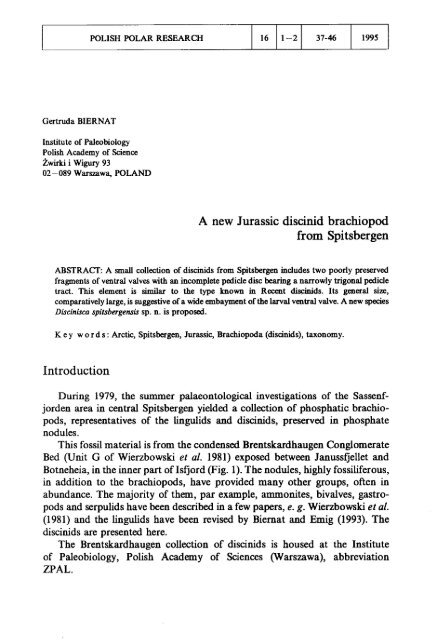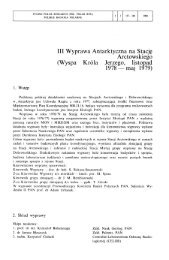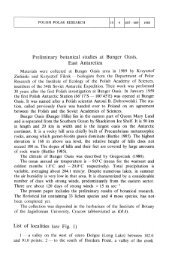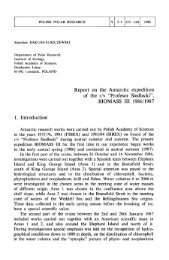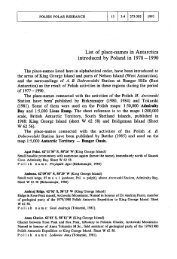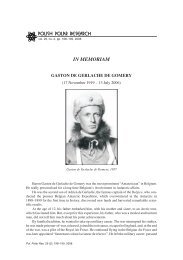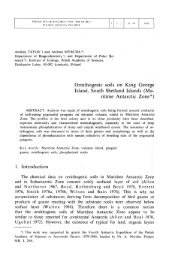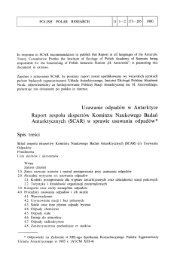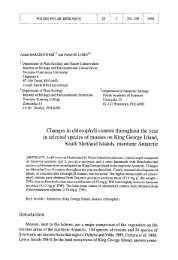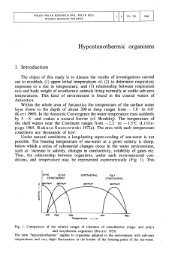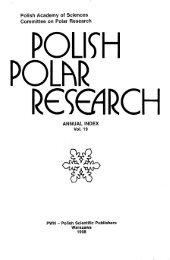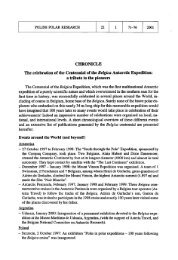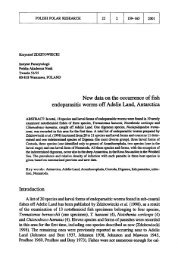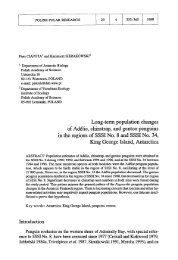A new Jurassic discinid brachiopod from Spitsbergen Introduction
A new Jurassic discinid brachiopod from Spitsbergen Introduction
A new Jurassic discinid brachiopod from Spitsbergen Introduction
Create successful ePaper yourself
Turn your PDF publications into a flip-book with our unique Google optimized e-Paper software.
Gertruda BIERNAT<br />
POLISH POLAR RESEARCH 16 1-2 37-46 1995<br />
Institute of Paleobiology<br />
Polish Academy of Science<br />
Żwirki i Wigury 93<br />
02-089 Warszawa, POLAND<br />
A <strong>new</strong> <strong>Jurassic</strong> <strong>discinid</strong> <strong>brachiopod</strong><br />
<strong>from</strong> <strong>Spitsbergen</strong><br />
ABSTRACT: A small collection of <strong>discinid</strong>s <strong>from</strong> <strong>Spitsbergen</strong> includes two poorly preserved<br />
fragments of ventral valves with an incomplete pedicle disc bearing a narrowly trigonal pedicle<br />
tract. This element is similar to the type known in Recent <strong>discinid</strong>s. Its general size,<br />
comparatively large, is suggestive of a wide embayment of the larval ventral valve. A <strong>new</strong> species<br />
Discinisca spitsbergensis sp. n. is proposed.<br />
Key words: Arctic, <strong>Spitsbergen</strong>, <strong>Jurassic</strong>, Brachiopoda (<strong>discinid</strong>s), taxonomy.<br />
<strong>Introduction</strong><br />
During 1979, the summer palaeontological investigations of the Sassenfjorden<br />
area in central <strong>Spitsbergen</strong> yielded a collection of phosphatic <strong>brachiopod</strong>s,<br />
representatives of the lingulids and <strong>discinid</strong>s, preserved in phosphate<br />
nodules.<br />
This fossil material is <strong>from</strong> the condensed Brentskardhaugen Conglomerate<br />
Bed (Unit G of Wierzbowski et al. 1981) exposed between Janussfjellet and<br />
Botneheia, in the inner part of Isfjord (Fig. 1). The nodules, highly fossiliferous,<br />
in addition to the <strong>brachiopod</strong>s, have provided many other groups, often in<br />
abundance. The majority of them, par example, ammonites, bivalves, gastropods<br />
and serpulids have been described in a few papers, e. g. Wierzbowski et al.<br />
(1981) and the lingulids have been revised by Biernat and Emig (1993). The<br />
<strong>discinid</strong>s are presented here.<br />
The Brentskardhaugen collection of <strong>discinid</strong>s is housed at the Institute<br />
of Paleobiology, Polish Academy of Sciences (Warszawa), abbreviation<br />
ZPAL.
38 Gertruda Biernat<br />
Fig. 1. Sketch-map showing location of Sassenfjorden area, central <strong>Spitsbergen</strong> investigated during<br />
the Fourth Polish Palaeontological Expedition to <strong>Spitsbergen</strong> in 1979; Sassenfjorden area arrowed.<br />
Previous records<br />
The typical Brentskardhaugen Bed (a regional marker horizon) has been<br />
reported <strong>from</strong> many regions of <strong>Spitsbergen</strong> (Birkenmajer 1972, Birkenmajer<br />
and Pugaczewska 1975, Parker 1967; Pćelina 1965, 1967; Wierzbowski et al.<br />
1981, Backstróm and Nagy 1985). Reports on the fossil content (the phosphate<br />
<strong>brachiopod</strong>s included) and stratigraphic range of the phosphorite conglomerates<br />
are scattered in publications dealing with the <strong>Jurassic</strong> strata of the Island.<br />
With regard to the phosphate <strong>brachiopod</strong>s, these are briefly described and<br />
illustrated, among others, in a paper of Birkenmajer and Pugaczewska (1975)<br />
on southern <strong>Spitsbergen</strong>, SW Torell Land and were considered to be of
A <strong>new</strong> <strong>Jurassic</strong> <strong>brachiopod</strong> 39<br />
Toarcian/Bajocian age. In turn, the fauna is mentioned by Wierzbowski et al.<br />
(1980) and, partly described (lingulids) by Biernat and Emig (1993) <strong>from</strong><br />
Sassenfjorden area, along its southern coast; it is considered to be Toarcian/Aalenian<br />
in age. Backstróm and Nagy (1984) briefly described and figured<br />
their record of <strong>brachiopod</strong>s <strong>from</strong> the phosphorite pebbles, Central <strong>Spitsbergen</strong>,<br />
localities 5, 7, 8, 17 (op. cit. 1985, p.31) referring them to the Bajocian, after<br />
Pompeckij (1900).<br />
Material<br />
The fossiliferous phosphorite nodules vary in size depending on the nature<br />
of the enclosed fossils (see Backstróm et al., 1985). Those preserving <strong>discinid</strong>s<br />
(usually two or more specimens) are, generally, small (to about 20 mm long) and<br />
more round in outline in comparison with nodules containing lingulids. All the<br />
<strong>brachiopod</strong>s are preserved as internal or external moulds, in different degrees of<br />
completeness, with attached (rarely in <strong>discinid</strong>s) fragments of shell (PI. 1, Figs<br />
1-5).<br />
The collection of <strong>discinid</strong>s, in contrast to that of the lingulids (compare<br />
Biernat and Emig 1993), is much less abundant. It comprises thirty separate<br />
dorsal valves nearly of uniform size and often bilaterally compressed, their<br />
length rarely exceeding 12 mm. Present are also three <strong>discinid</strong> specimens,<br />
"seemingly complete — that is to say ?articulated", narrowly elongate with<br />
surfaces distinctly polished and shining. These <strong>discinid</strong> "shells" are composed,<br />
incidentally, of two dorsal valves (their apices lying oppositely) almost perfectly<br />
fitted together along all their margins (PI. 1, Fig. 2) and having some parts of<br />
each valve correspondingly truncated. This preservation is a result of, among<br />
others, a highly turbulent environment favouring the segregation of the fossils,<br />
their conversion to moulds and their breakage.<br />
Included are, also, small fragmentary moulds of the ventral valve delicately<br />
impressed on the dorsal valve exterior. One preserves an incomplete pedicle disc<br />
(available for study) superimposed on the apical area of the dorsal valve (PI. 1,<br />
Fig. 1; PI. 2, Figs 1-2).<br />
Systematic description<br />
Family Discinidae Gray, 1840<br />
Subfamily Disciniscinae Schuchert et LeVene, 1929<br />
Genus Discinisca Dall, 1971<br />
Remarks. — Fossil <strong>discinid</strong>s remain imperfectly known, particularly their<br />
internal structure: as a rule, it is rarely preserved in available records. A lack of
40 Gertruda Biernat<br />
discriminating, taxonomically valuable, characters makes generic and specific<br />
assignments difficult. Hitherto identifications were based, by necessity, mostly<br />
on the dorsal valve exteriors, usually the only valves preserved.<br />
Most species referred to the genus Discinisca Dall have dorsal valves, to<br />
a varying degree of rounded outline, lowly conical with subcentral apexes, and<br />
a surface concentric sculpture with or without radial costellae (Dall 1920,<br />
Thomson 1927).<br />
Regarding the radial ornament it was recognized as a character readilly<br />
distinguishing the radiate <strong>discinid</strong>s <strong>from</strong> the nonradiate forms (Dall 1920, p.<br />
275; Muir-Wood 1929 p. 468; 1939, p. 156; Hertlein and Grant 1944, p. 26;<br />
Cooper 1977, p. 51). Accordingly, the radially ornamented Discradisca was<br />
recognized (Stenzel 1964) as a subgenus of Discinisca Dall and, in turn, elevated<br />
to generic rank by Cooper (1977). However, Hammond (1980) considered that<br />
genus to be unjustified being based, solely, on the surface ornamentation and<br />
proposed to retain Discradisca, temporarily, at the subgenus level. Indeed,<br />
radial ornamentation although sufficiently well distinguishing Discradisca <strong>from</strong><br />
Discinisca, may appear to be inadequate as the only criterion diagnostic at the<br />
genus level. To mention, appearance of the radiating sculpture (i. e. thickness,<br />
frequency of bifurcation) may vary within one species, often considerably: <strong>from</strong><br />
thick ribs to very fine ones with a tendency to dissapearance (Dall 1920, p. 277;<br />
Radwańska and Radwański 1989, p. 75).<br />
According to suggestions of Hammond (1980) additional criteria based on<br />
the ventral valve morphology (including the larval characters) should be<br />
regarded as valuable in defining the three <strong>discinid</strong> genera: Palagodiscus Dall,<br />
Discinisca (Discinisca) Dall and Discinisca (Discradisca) Stenzel. His proposed<br />
taxonomic review of Discinidae (based on these criteria) is not published yet.<br />
In addition, the <strong>new</strong>ly described (Radwańska and Radwański 1994) subgenus<br />
Discinisca (Arquinisca) with D. (A) vistulae sp. n. <strong>from</strong> the Cretaceous strata<br />
(topmost Maastrichtian) of Poland is based on the dorsal valve morphology<br />
only (ventral valve unknown). Its main characterics comprise: the elongated, to<br />
a varying degree, postlarval (adult) valve of dome-like profile with eccentral<br />
apex and well developed surface concentric lines. The authors define their <strong>new</strong><br />
taxon as well distinguishing among the <strong>Jurassic</strong> and Tertiary counterparts.<br />
Generally speaking, the taxonomic procedure within family is still vague and<br />
the generic status of the disciniscid taxa remains unclear.<br />
The <strong>Spitsbergen</strong> <strong>discinid</strong>s were assigned by Backstróm and Nagy (1985, p.<br />
31) to the genus Discinisca Dall. Their generic status is, here, pending the<br />
availability of more and better material, taxonomically decessive, particularly of<br />
the ventral valves.<br />
Note on the pedicle disc area. — External mould of the pedicle tract with<br />
adherent areas, is the main morphological element preserved, although poorly<br />
(PI. 1, Fig. 1). It is rather widely trigonal than oval, comparatively large and
A <strong>new</strong> <strong>Jurassic</strong> <strong>brachiopod</strong> 41<br />
occupies about one-fifth or more of the area of the available valve (PI. 1, Fig. 1).<br />
The pedicle disc resembles a similar structure in the Recent Discinisca lamellosa<br />
Broderip 1833 (i. e. Rowell in Moore 1965 H286, Fig. 178-3a) as well as in the<br />
Recent (Chile) Discinisca sowerbyi Muir-Wood 1936, (op. cit. 1936, p.473, Fig. 3)<br />
with the difference, that in the latter forms it is more disctinctly oval. It may<br />
correspond also to the pedicle disc in the adult forms of Discinisca (Discradisca)<br />
and Pelagodiscus atlanticus King discussed by Hammond (1980). That author<br />
considered the larger size and shape of the pedicle disc in the above forms as<br />
"reminiscence of the development of a wide embayment the ventral larval<br />
valve", like in the other, studied by him, specimens of <strong>discinid</strong> larvae (pp. cit.<br />
1980, p. 659).<br />
The median element of the pedicle disc, corresponding to the pedicle fissure,<br />
appears to be "originally" narrowly trigonal (PI. 2) very much like that of the<br />
Triassic (Anisian, Carnian) Orbiculoidea sibirica Moisseiev, 1947 figured and<br />
briefly described by Dagys (1965, p. 18; P. 1, Fig. 17a, 19a). It extends<br />
posteriorly, and presumably, as a continuation of the internal ?apical septal<br />
ridge, fairly marked (PI. 1, Fig. 1; PI. 2).<br />
More detailed morphology of both the fissure and the pedicle foramen<br />
remains indefinable since both are obliterated by the rock matrix. One can<br />
suggest that the appearance of the above, particularly of the second one, does<br />
not differ greatly <strong>from</strong> those in the living <strong>discinid</strong>s and the pedicle foramen may<br />
look like a slit.<br />
Surface ornamentation of the preserved parts of the valve and of the pedicle<br />
disc consists of rugae, differentiated in breadth, interrupted by a pedicle fissure.<br />
Rugae at the apex are thinner and of more uniform appearance, with growth,<br />
their pattern becomes more step-like (PI. 1, Fig. 1; PI. 2, Figs 1—2).<br />
Additionally, some parts of valve bear fine and widely spaced lines,<br />
two-three per 1 mm, crossing (somewhat angularly) concentric rugae in<br />
a way similar to those observed in a specimen of the Recent Pelagodiscus<br />
sp. <strong>from</strong> the collection of Dr. Chr. Emig (Marine Station, Marseille). These<br />
lines may be connected with the location of setae along the mantle margins<br />
and concentric lines? described on a number of lingulacean genera (compare<br />
Savazzi, 1986, p. 59).<br />
It is worth to mention that, on the dorsal apical area, anteriorly to the<br />
pedicle disc, two rounded scars lying very close one to another are preserved.<br />
They are deformed (one more enlarged) and, somewhat displaced (PI. 2, Fig. 1).<br />
Each of them is surrounded by a darker rim supposedly connected with the<br />
decay of organic matter. Their general appearance and location may be<br />
suggestive of the dorsal adductor muscle scars. These look very much like the<br />
dorsal "retractors" sensu Davidson (1888, PI. 26, Figs 23 — 25) and, the anterior<br />
adductors (Thomson 1927, Fig. 38b) in Discinisca lamellosa Broderip, or in D.<br />
variabilis (Thomson 1971, Figs 4b, 6) and Pelagodisus atlanticus figured by Lee<br />
(1987, Fig. B: f)- The above interpretation seems probable.
42 Gertruda Biernat<br />
Discinisca spitsbergensis sp. n.<br />
PI. 1. Figs 1-7; PI. 2. Figs 1-2)<br />
1829. cf. Orbicula reflexa Sowerby; p. 4, PI. 506, Fig. 1.<br />
1900. cf. Discina reflexa (Sowerby); Pompeckij, p. 58, PI. 1, Figs 6-9.<br />
1985. Discinisca cf. reflexa (Sowerby 1829); Backstróm and Nagy, p. 31, PI. 1, Figs 3—5.<br />
Holotype: ZPAL Bp. XXIVa/l, PI. 1, Fig. 4; Paratype: ZPAL Bp.<br />
XXIVa/2, PI. 1, Fig. 1.<br />
Type locality: Wimanfjellet (between Janussfjellet and Botneheia), Sassenfjorden<br />
area, central <strong>Spitsbergen</strong>.<br />
Type horizon: Brentskardhaugen Bed (phosphorite nodules), <strong>Jurassic</strong><br />
Toarcian/Aalenian (Wierzbowski et al. 1981).<br />
Etymology: spitsbergensis — relates to the type locality — <strong>Spitsbergen</strong>.<br />
Material and occurrence. — Thirty disarticulated external and internal moulds<br />
of dorsal valves, partly exfoliated, two fragmentary ventral valves. All material<br />
comes <strong>from</strong> the Brentskardhaugen Conglomerate Bed (phosphorate nodules) of<br />
Wimanfjellet (between Jaanussfjellet and Botneheia), Sassenfjorden, central<br />
<strong>Spitsbergen</strong>.<br />
Diagnosis. — Small, rounded to oval, lowly conical species, apex subcentral and<br />
pointed, posterior margin evenly cutted, pedicle tract narrowly trigonal with<br />
PLATE l<br />
Discinisca spitsbergensis sp. n. 1. Fragmentary mould of a ventral valve, paratype (ZPAL Bp.<br />
XXIVa/2, apical view, pedicle disk partly preserved; 2—7. Dorsal valves in different state of<br />
preservation: 2. paratype (ZPAL Bp. XXIVa/453) with two dorsal valves tightly conjoint; 3.<br />
incomplete paratype (ZPAL Bp. XXIVa/495; 4. holotype ZPAL Bp. XXIVa/1) seriously decorticated<br />
with subcentral apex and very weak traces of muscle scars; 5 — 7. paratypes (ZPAL Bp.<br />
XXIVa/487, ZPAL Bp. XXIVa/489, ZPAL Bp. XXIVa/490), all with subcentral and marked apex.<br />
All xl<br />
Phosphorite nodules of the Brentskardhaugen Bed Toarcian/Aalenian, Wimanfjellet, Sassenfjorden.<br />
PLATE 2<br />
Discinisca spitsbergensis sp. n. Fragmentary mould of a ventral valve, paratype (ZPAL Bp.<br />
XXIVa/2).<br />
Fig. 1 — incomplete pedicle disk (pd) with a median pedicle Assure (pf) bordered by two, poor,<br />
adherent areas (aa) and bearing traces of concentric rugae (cr) of varying breadth; at the apex traces<br />
of ?dorsal adductor scars (d a a) being marked. Fig. 2 — focussed on a median pedicle fissure (pf)<br />
and on adherent area (aa).<br />
Phosphorite nodules of the Brentskardhaugen Bed Toarcian/Aalenian, Wimanfjellet, Sassenfjorden.
POLISH POLAR RESEARCH, VOL. 16 G. BIERNAT, PL. 2
POLISH POLAR RESEARCH, VOL. 16 G. BIERNAT, PL. 1
A <strong>new</strong> <strong>Jurassic</strong> <strong>brachiopod</strong> 43<br />
quite large adherent areas; width and arrangement of the surface concentric<br />
lines varying, particularly on the adult shell.<br />
Description — Dorsal valve small, rarely exceeding 12 mm in length, lowly<br />
conical in profile, somewhat oval or almost circular in outline; apex subcentral,<br />
moderately pointed; posterior slope somewhat flattish and its margin insignificantly<br />
truncated or slightly rounded; anterior slope lightly elongated with<br />
rounded margins.<br />
Surface concentric lines of varying width and arrangement, usually with three to<br />
five thinner lines in between the two thicker ones, the latter, often look like<br />
discontinuous corrugations particularly at the marginal areas (PI. 1, Fig. 3); very<br />
faint and discontinuous traces of radial "capillae" are seen on small shell patches.<br />
One decorticated valve shows very poor and fragmentary traces of ? mantle canals<br />
(vascula media) and, probably of anterior adductors (PI. 1, Fig. 4), the latter may<br />
correspond to those of the living Discinisca figured by Rudwick (1970, Fig. 10c).<br />
Ventral valve. Small, flattened with somewhat convex peduncular area;<br />
pedicle fissure of narrowly trigonal outline: pedicle foramen probably slit like<br />
(PI. 1, Fig. 1; PI. 2, Figs 1—2), a short apical ?septal ridge traceable.<br />
Surface concentric lines, somewhat irreglarly arranged, of varying width,<br />
and deflected on the pedicle area: discontinuous when at both borders of the<br />
pedicle fissure. They are, additionally, crossed by very fine radial thread - like<br />
lines, two per 1 mm.<br />
Remarks. — Backstróm and Nagy (1985) regarded the <strong>discinid</strong>s <strong>from</strong> <strong>Spitsbergen</strong>,<br />
as being almost identical with Discinisca reflexa (Sowerby) poorly<br />
illustrated and described by Pompeckij (1900; p. 58, PI. 1, Figs 6 — 9), who<br />
identified them as Discinisca cf. reflexa (Sowerby). As a matter of fact, that<br />
species, independently of the records usually inadequate for identification, has<br />
been often cited <strong>from</strong> <strong>Jurassic</strong> (mainly Lias) localities (i.e. Davidson 1851,1876;<br />
Rollier 1915). This is, however, a controversial species. Above all, its appropriate<br />
interpretation is hindered by the fact that the formation and locality of the type<br />
of the species is still unclear. That problem has been briefly discussed by<br />
Muir-Wood (1936) who provided some data on the species in question, including<br />
nomenclatural corrections (op. cit. 1936, pp. 476 — 477); in addition, Whitby<br />
(England) was suggested as a supposed locality of the two syntypes of D. reflexa<br />
originally described and figured by G.B. Sowerby in 1825, p. 321, PI. 11, Fig. 7).<br />
D. spitsbergensis sp. nov., in size and general outline, resembles the<br />
specimens mentioned and figured by the above authors as D. reflexa. It differs<br />
in having lower dorsal valve, a more subcentral (posterior) apex cutted posterior<br />
margin and, unknown till now, widely trigonal pedicle disc.<br />
D. holdeni (Tate), briefly described <strong>from</strong> the Lias (Dorset) by Muir-Wood<br />
(1936; p. 473, Figs la — lb), is smaller, its dorsal valve, being higher and apex
44 Gertruda Biernat<br />
lying more centrally. The ventral valve of D. langi Muir-Wood (the only<br />
preserved) <strong>from</strong> the Lower Lias of Dorset is of much larger size with broader<br />
concentric rugae; the pedicle disc, unfortunately, is not preserved (Muir-Wood<br />
1936; p. 474, Text — fig. 2). The Triassic Orbiculoidea sibirica Moisseiev <strong>from</strong><br />
Siberia is more elongate with higher dorsal valve and has a more central apex<br />
pagys 1965, p. 6, PI. 1, Figs 17 — 20). The Carnian Orbiculoidea sp., (basin of<br />
the Kolyma River) is much larger in size, the dorsal apex more central and<br />
concentric lines are thinner {pp. cit. 1965; PI. 2, Fig. 1).<br />
Conclusions<br />
1. The shell morphology, particularly of the ventral valve, justify erection of<br />
a <strong>new</strong> species.<br />
2. The widely trigonal pedicle disc, recognized up to now, in only the<br />
Triassic and <strong>Jurassic</strong> disciniscid <strong>brachiopod</strong>s may proved characteristic of the<br />
Mesozoic forms.<br />
3. The comparatively large size of the pedicle disc in Discinisca spitsbergensis<br />
sp. n. may be indicative of a wide embayement in the larval ventral<br />
valve.<br />
4. The few traces of the ventral valve moulded on the dorsal one may<br />
suggest that the latter could serve as a substrate for attachement of juvenile<br />
<strong>discinid</strong>s in like manner as the Recent <strong>discinid</strong>s (Rowell 1965, Taylor 1971,<br />
Ricards 1973, Watson 1982).<br />
Acknowledgements. — The author is indebted to Dr. Christian Emig (Marine Station d'Endoume,<br />
Marseille) for supplying the collection of Recent <strong>discinid</strong>s and literature for study; to<br />
Dr. Lars Holmer (Institute of Earth-Historical Geology and Palaeontology, Uppsala) for providing<br />
me with data on the Lingulata and Dr. David Harper (Geology Department, University<br />
College Galway) for critical reading of the manuscript; to Dr. Cyprian Kulicki (Institute of<br />
Paleobiology, Warszawa) for his help in SEM photos. The ordinary photographs were taken by<br />
Mrs. G. Dziewińska and plates being prepared by Miss D. Kościelska (both <strong>from</strong> the Institute<br />
of Paleobiology, Warszawa).<br />
References<br />
BACKSTRÓM S.A. and NAGY J. 1985. Depositional history and fauna of a <strong>Jurassic</strong> phosphorite<br />
conglomerate (the Brentskardhaugen Bed) in <strong>Spitsbergen</strong>. — Norsk Polarinstitutt Skrifter, 183:<br />
5-61.<br />
BIERNAT G. and EMIG C.C. 1993. Anatomical distinctions of the Mesozoic lingulide <strong>brachiopod</strong>s.<br />
— Acta Palaeont. Polonica, 38, (1 -2): 1 -20.<br />
BIRKENMAJER K. 1972. Magaripples and phosphorite pebbles in the Rhaeto-Liassic beds south<br />
of Van Keulenfjordeen, <strong>Spitsbergen</strong>. —Norsk Polarinstitutt Arbok 1970: 117-127.<br />
BIRKENMAJER K. and PUGACZEWSKA H. 1975. <strong>Jurassic</strong> and Lower Cretaceous marine<br />
fauna of S.W. Torell Land, <strong>Spitsbergen</strong>. — Studia Geol. Polonica, 4: 45 — 84.
A <strong>new</strong> <strong>Jurassic</strong> <strong>brachiopod</strong> 45<br />
BULMAN O. M. B. 1939. Muscle systems of some Inarticulate Brachiopods. — Geol. Mag.<br />
London. 76: 434 -444.<br />
COOPER G. A. 1977. Brachiopods <strong>from</strong> the Carribean Sea and adjacent waters. — Studies in<br />
Tropical Oceanography, 14: 1 —140.<br />
DAGYS A. S. 1965. Triassic <strong>brachiopod</strong>s of Siberia. — Nauka, Moskva 1 -186.<br />
DALL W. H. 1920. Annotated list of the Recent Brachiopoda in the collections of the United<br />
States National Museum with description of thirty <strong>new</strong> forms. — Proc. U.S. Nat. Mus., 57:<br />
261-377.<br />
DAVIDSON T. 1851. A monograph of British Fossil Brachiopoda. — Palaeont. Soc., I: 1-23.<br />
DAVIDSON T. 1876. A monograph of the British fossil Brachiopoda. Supplement to the <strong>Jurassic</strong><br />
and Triassic species in Palaeont. — Palaeont. Soc, 30: 81 —88.<br />
DAVIDSON T. 1886-1888. A monograph of Recent Brachiopoda. — Trans. Linnean Soc.<br />
London, parts 1-3, 4: 1-248.<br />
HAMMOND L. S. 1980. The larvae of a <strong>discinid</strong> (Brachiopoda: Inarticulata) <strong>from</strong> inshore waters<br />
near Townsville, Australia, with revised identifications of previous records. — Journ. Nat.<br />
History, 14: 647 - 661.<br />
HERTLEIN L. G. and GRANT U. S. 1944. The Cenozoic <strong>brachiopod</strong>s of western North America.<br />
— Publ. Univ. Calif. Los Angeles, Math., Phys. Sci., 3: 1 -236.<br />
HOLMER L. E. 1989. Middle Ordovician phosphatic inarticulate <strong>brachiopod</strong>s <strong>from</strong> Vastergotland<br />
and Dalarna, Sweden. — Fossils and Strata, 26: 1 — 172.<br />
LEE D. E. 1987. Cenozoic and Recent inarticulate <strong>brachiopod</strong>s of New Zealand: Discinisca,<br />
Pelagodiscus and Neocrania. — Journ. Roy. Soc. New Zealand, 17, 1: 49 — 72.<br />
MUIR-WOOD H. 1929. A <strong>new</strong> <strong>brachiopod</strong> Discinisca ferroviae <strong>from</strong> the Woolwich Beds. — Proc.<br />
Geol. Assoc. London, 39: 463-470.<br />
MUIR-WOOD H. 1936. Brachiopoda <strong>from</strong> the Lower Lias, Green Ammonite Beds of Dorset.<br />
— Quart. Journ. Geol. Soc, London, 42: 472-485.<br />
MUIR-WOOD H. 1939. Four species of Discinisca (Brachiopoda) <strong>from</strong> the Eocene of the<br />
Hampshire Basin. — Proc. Geol. Assoc. London, 50: 149—158.<br />
PARKER J. R. 1967. The <strong>Jurassic</strong> and Cretaceous sequence in <strong>Spitsbergen</strong>. — Geol. Mag., 104,<br />
487-505.<br />
PĆELINA T. M. 1965. Stratigrafija i osobennosti vescestvennogo sostava mezozojskich otloźenij<br />
centralnoj ćasti Zapadnogo Spicbergena. — Naucno-Issledovatielnyi Institut Geologii Arktiki,<br />
p. 127- 148.<br />
PĆELINA T. M. 1967. Stratigrafija i nekotorye osobennosti vescestvennogo sostava mezozojskich<br />
otloźenij jużnych vostocnych rajonov Zapadnogo Spicbergena. Materyjaly po Geologyij<br />
Spicbergena. — Naucno-Isslovatelnyi Institut po Geologii Arktiki, 121 —158.<br />
POMPECK1J J. F. 1900. The <strong>Jurassic</strong> fauna of Cape Flora. In: Nansen F.: Geological sketch of<br />
Cape Flora and its neighbourhood. — The Norw. North Polar Exped. 1893-1896. Scientif.<br />
Res. 1: 54 - 58.<br />
RADWAŃSKA U. and RADWAŃSKI A. 1989. A <strong>new</strong> species of inarticulate <strong>brachiopod</strong>s.<br />
Discinisca steiningeri sp. nov., <strong>from</strong> the Late Oligocen (Egerian) of Plesching near Linz,<br />
Austria. — Ann. Naturhist. Mus. Wien, A. 90: 67-82.<br />
RADWAŃSKA U. and RADWAŃSKI A. 1994. The topmost Cretaceous disciniscan <strong>brachiopod</strong>s,<br />
Discinisca {Arquinisca subgen. n.) vistulae sp. n., <strong>from</strong> the Middle Vistula Valley, Central<br />
Poland. — Acta Geol. Polonica, 44 (3 -4): 251 -260.<br />
ROLLIER R. 1915. Synopsis des Spirobranches (Brachiopodes) Jurassiques Celto-Suabes.<br />
— Mem. Soc. Pal. Suisse, 41, 1: 20 -45.<br />
ROWELL A. J. 1965 Inarticulata. In: Moore R. C. (ed.), Treatise on Invertebrate Paleontology, (H)<br />
Brachiopoda. — Geol. Soc America and University of Kansas Press, Lawrence, H260 — H296.<br />
RUDWICK M. J. S. 1970. Living and fossil <strong>brachiopod</strong>s. — Biol. Sci. Hutchinson and Co<br />
Publishers, 1-199.
46 Gertruda Biernat<br />
SAVAZZI E. 1986. Burrowng sculptures and life habits in Paleozoic lingulacean <strong>brachiopod</strong>s.<br />
— Paleobiol., 12, 1: 46 - 63.<br />
SOWERBY G. B. 1825. Description of two <strong>new</strong> species of the genus Orbicula. — Zool. Journ.<br />
London, II, p. 320.<br />
SOWERBY J. de C. 1826-1829. The mineral conchology of Great Britain 6. London.<br />
STENZEL H. B. 1964. Stratigraphic and palaeoecologic significance of a <strong>new</strong> Danian <strong>brachiopod</strong><br />
species <strong>from</strong> Texas. — Geol. Rundschau, 54: 619 — 631.<br />
TAYLOR B. J. 1971. Thalophyte borings in phosphatide fossils <strong>from</strong> the Lower Cretaceous of<br />
South-East Alexander Island, Antarctica. — Palaeontology, 14, 2: 294 — 302.<br />
THOMSON J. A. 1927. Brachiopod morphology and genera (Recent and Tertiary). — New<br />
Zealand Board, Sci. and Art. Manual, 7: 338.<br />
THOMSON M. R. A. 1971. Inarticulate <strong>brachiopod</strong>s <strong>from</strong> the Lower Cretaceous of South-Eastern<br />
Alexander Island. — British Antarctic Surv. Bull., 25: 85 — 94.<br />
WATSON J. S. 1982. The occurrence of Discinisca on Dacryomya ovum: an example of<br />
commensalism <strong>from</strong> the Upper Lias of Yorkshire. — Proc. Yorkshire Geol. Soc., 44 (3):<br />
45-51.<br />
WIERZBOWSKI A., KULICKI C. and PUGACZEWSKA H. 1981. Fauna and stratigraphy of<br />
the uppermost Triassic and the Toarcian and Aalenian in the Sassenfjorden, <strong>Spitsbergen</strong>.<br />
Acta Palaeont. Polonica, 26 (3 - 4): 195 - 241.<br />
Streszczenie<br />
Received March 14, 1995<br />
Accepted May 30, 1995<br />
Badania ramienionogów (<strong>discinid</strong>ów) z fosforytów warstwy Brentskardhaugen (jednostka G:<br />
Wierzbowski et al., 1981) rejonu Sassenfjorden w centralnej części <strong>Spitsbergen</strong>u (fig. 1) wykazały, że<br />
stanowią one nowy gatunek Discinisca spitsbergensis sp. n. (pl. 1 — 2). Zachowany fragmentarycznie<br />
dysk nóżkowy (pl. 1, fig. 1; pl. 2, fig. 1—2) stosunkowo duży, w porównaniu z niewielkimi<br />
rozmiarami skorupki wykazuje znaczne podobieństwo do dysku u współcześnie żyjących <strong>discinid</strong>ów.<br />
Niewielka różnica dotyczy głównie zarysu tego elementu — trójkątny u gatunku<br />
spitsbergeńskiego i owalny u form współczesnych. Podobny (trójkątny) dysk zaobserwowano<br />
również u triasowego gatunku Orbiculoidea sibirica Moisseiev (Dagys 1965; pl. 1, fig. 19a) z Syberii.<br />
Wydaje się, że kształt dysku nóżkowego może być istotną diagnostycznie (dla rodzaju) cechą.<br />
Niewątpliwie, zarysowuje się tutaj pewna tendencja w kierunku zmiany w zarysie dysku nóżkowego.<br />
Na wykazanie tego potrzebna jest kompletniejsza dokumentacja kopalna.


